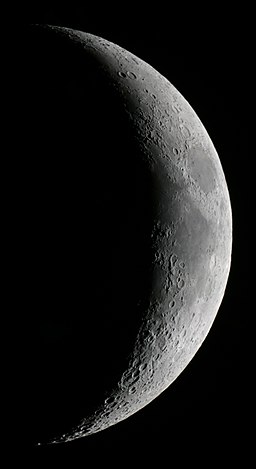There seems to be a mix of streetlamps here with the lamps changing from one pole to the next. I annotated the photo below to show the difference in glare between poorly designed lamps and full cutoff lamps:
 |
| Streetlamps by Christopher Kyba is licensed under a Creative Commons Attribution 4.0 International License. |
I saw a lot of examples of incredibly bad parking lot lighting, and this was the worst:
 |
| Dark shadows by Christopher Kyba is licensed under a Creative Commons Attribution 4.0 International License. |
The lamp is basically inside of a tree, so there is a huge area of the parking lot that's unlit. It's not a real streetlight, it's just a floodlight tipped at an angle, so that it sprays light everywhere - except on half of the parking lot! You can see that it shines directly into the house windows as well - and that someone is awake (a light is on). Maybe they have insomnia because of the glaring lamp shining in their bedroom?
 |
| Floodlit house by Christopher Kyba is licensed under a Creative Commons Attribution 4.0 International License. |
I really don't understand what's going on in the next two photos. There is a really bright and poorly directed floodlight, but I'm not sure if it's supposed to be lighting the parking lot or the building facade. In the first photo, you can see that it's a really glaring light that is particularly poorly situated: right before drivers will make a left turn through a pedestrian crosswalk:
 |
| Turning hazard by Christopher Kyba is licensed under a Creative Commons Attribution 4.0 International License. |
I often hear that lights are bright in the US because of fears of litigation. But couldn't a driver that hits a pedestrian blame it on the glaring floodlight and sue the business? The next photo shows how glaring the lamp is for pedestrians:
 |
| Glaring lamp by Christopher Kyba is licensed under a Creative Commons Attribution 4.0 International License. |
And finally the business itself. At first I assumed that this was supposed to be facade lighting, but after seeing more parking lots I think the facade lighting may be accidental:
 |
| Lit facade by Christopher Kyba is licensed under a Creative Commons Attribution 4.0 International License. |
Here is a gas station that should really be using recessed lighting. It would eliminate the glare, and leave a similar brightness at the pumps:
 |
| Poorly lit gas station by Christopher Kyba is licensed under a Creative Commons Attribution 4.0 International License. |
You can see the same kind of floodlight disaster on part of the parking lot of the station:
 |
| Floodlit parking lot by Christopher Kyba is licensed under a Creative Commons Attribution 4.0 International License. |
But right across the street is a WONDERFUL example of how parking lots should be lit! Just look at how little glare there is! The parking lot itself had extremely good visibility, and was very well lit. Of course, since the bank is closed at 3 am, it's unclear whether the lamps need to be on...
 |
| Well lit parking lot by Christopher Kyba is licensed under a Creative Commons Attribution 4.0 International License. |
Finally, here are the glaringly white lights of our hotel parking lot. The surface brightness was probably similar to the photo above, but it was much less comfortable to walk there because of the glare:
 |
| Parking lot with glaring lamps by Christopher Kyba is licensed under a Creative Commons Attribution 4.0 International License. |
In case anyone wants the original copy of the first image (e.g. to translate the text), here it is:
 |
| Streetlights by Christopher Kyba is licensed under a Creative Commons Attribution 4.0 International License. |





